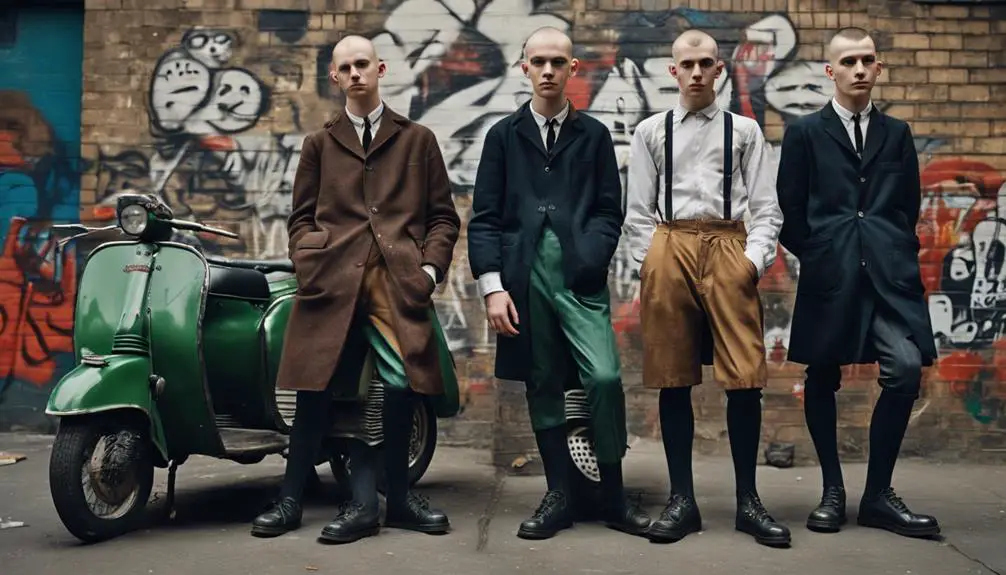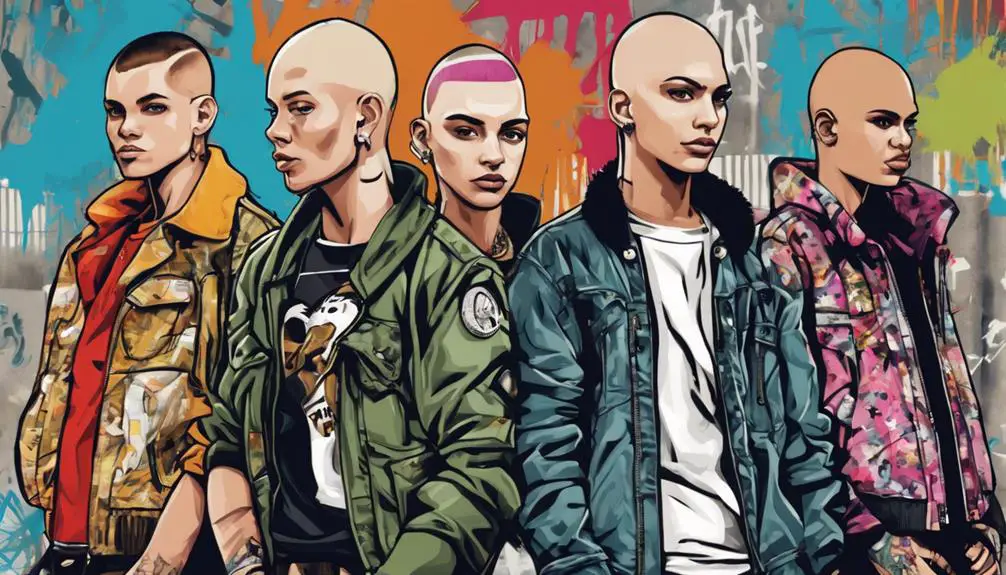Did you know that over 50% of skinheads today identify with a sense of community that transcends the negative stereotypes often associated with the subculture? This fascinating evolution showcases a blend of fashion, music, and political dynamics that reflects both heritage and identity. As you explore the origins and elements that define skinhead culture, you'll uncover the complexities that challenge common perceptions. What lies beneath the surface of this seemingly straightforward style?
Origins of Skinhead Culture

In the 1960s, skinhead culture emerged among working-class youth in London's neighborhoods, drawing inspiration from mod and rude boy styles as well as Jamaican music. This vibrant subculture celebrated communal solidarity and alternative values, creating a unique identity that resonated with early skinheads. These individuals embraced mod fashion elements, such as tailored trousers and button-down shirts, but also added their own twist with shaved heads and heavy boots, symbolizing their working-class roots.
Initially, the skinhead movement was nonpolitical, focusing on music and camaraderie. Jamaican music, particularly ska, played a significant role in shaping the culture, fostering a sense of unity among diverse groups. However, as the late 1960s rolled in, media attention shifted to the movement due to incidents of football hooliganism and violence involving immigrant communities, altering public perception.
By the 1970s and 80s, the skinhead movement began to expand internationally, evolving from its nonpolitical roots. Unfortunately, this evolution led to associations with extreme nationalist and neo-Nazi groups, overshadowing the original spirit of the subculture. Despite this shift, the essence of early skinheads remains significant, as they laid the groundwork for future movements, including punk music, which adopted and adapted various elements from skinhead culture.
Cultural representations, like films such as *Romper Stomper* and *American History X*, further illustrate the evolving identity of skinheads, showcasing both their communal origins and the complex narratives that emerged over time.
Fashion and Style Elements
Skinhead fashion is instantly recognizable, defined by its distinctive elements that blend working-class practicality with a rebellious edge. When you step into the world of skinhead style, you're diving into a bold aesthetic that pays homage to its roots. The closely-cropped or shaved heads of men, along with women sporting mod-style short feather cuts, set the tone for this look.
At the core of skinhead fashion are fundamental garments like button-down shirts, especially those iconic Ben Sherman pieces. You'll often see gingham patterns paired with Sta-Prest slacks or classic shrink-to-fit Levi 501 jeans, all reflecting those strong working-class roots. Vintage clothing, such as vintage Ralph Lauren pieces, can also complement this style, adding a touch of authenticity and quality. Footwear is vital, as Dr. Martens boots dominate the scene; they're often worn with jeans tucked in, showcasing the boots' striking design and durability.
Accessories elevate the overall style, with braces adding a touch of flair, and trilby or pork pie hats completing the ensemble. Notably, the check sizes on shirts can signal gang hierarchy, with larger checks representing greater authority within skinhead groups, adding an extra layer of meaning to the fashion choices.
This style has evolved from the initial influences of Mod and rude boy fashion to a more aggressive aesthetic often linked to football hooliganism in the late 1970s. Embracing skinhead fashion is about more than just clothing; it's a statement of identity, pride, and a nod to a rich cultural history that remains vibrant today.
Musical Influences and Impact

Fashion isn't the only defining aspect of the skinhead subculture; music plays a crucial role in shaping its identity and evolution. The early skinhead movement was heavily influenced by West Indian reggae, with artists like Desmond Dekker and The Pioneers providing a vibrant soundtrack in the late 1960s. This musical foundation laid the groundwork for what would come next.
In the late 1970s, the emergence of the 2 Tone genre blended ska, reggae, and punk rock, featuring influential bands like The Specials and Madness. These groups not only entertained but also shaped the skinhead identity, reflecting a sense of unity and cultural pride. Oi! music, another significant subgenre that arose around the same time, spotlighted street issues with a raw, working-class punk sound. Bands like Cockney Rejects and The 4-Skins exemplified this movement, capturing the ethos of skinhead culture with their powerful lyrics and energetic performances.
As the 1980s rolled in, the politicization of skinhead culture led to divisions within the music scene. While some factions aligned with neo-Nazi politics, others, like Skinheads Against Racial Prejudice, fought against intolerance, showcasing the complex legacy of the movement. Today, skinhead music continues to evolve with new bands and events, maintaining the cultural significance while steering through its diverse influences. Through it all, music remains a crucial piece of the skinhead identity, bringing people together and celebrating a rich heritage.
Political Affiliations and Divisions
While the skinhead subculture is often associated with a singular narrative of extremism, the reality is much more nuanced, reflecting a wide array of political affiliations and divisions. In the early 1980s, many skinheads aligned themselves with far-right groups like the National Front and British Movement, which laid the groundwork for a complex political landscape. As neo-Nazi movements emerged in the 1990s, the divisions intensified, creating a clear rift within the community.
However, it is crucial to recognize that the skinhead subculture isn't solely defined by these extremist views. Counter-movements like Skinheads Against Racial Prejudice (SHARP) arose to promote anti-racist ideologies, effectively challenging the dominant narrative that often paints skinheads as extremists. Many individuals within this subculture identify as apolitical, embracing a spectrum of beliefs that encompasses both leftist and right-wing perspectives. This diversity highlights that not every skinhead subscribes to racial prejudice or extremist ideologies.
The ongoing debates about skinhead identity reveal the complexity of this movement. You'll find passionate individuals advocating for various beliefs, from anti-racism to political apathy. This kaleidoscope of thought showcases the rich tapestry of the skinhead subculture, reminding us that it's not a monolith but rather a vibrant community with differing views. By understanding these political affiliations and divisions, you gain a deeper appreciation for the multifaceted nature of skinhead culture, celebrating its diversity and challenging preconceived notions.
Contemporary Perspectives and Trends

The contemporary skinhead scene is a vibrant mix of old and new, where traditional styles merge with punk influences and a variety of music genres like Oi! and 2 Tone. This evolution reflects a broader cultural shift, highlighting how skinheads express their working-class identity through fashion and music while embracing diversity. You'll find that the scene isn't just confined to the UK anymore; it has spread globally, leading to unique adaptations in places like China, where local interpretations of fashion and music flourish.
Annual events, such as the Big 40, celebrate skinhead heritage and foster connections among enthusiasts, creating a sense of community that transcends borders. However, the political landscape within the skinhead subculture is complex. While some factions embrace anti-racist movements like SHARP, which promotes inclusivity, others align with more extreme nationalist ideologies. This duality sparks ongoing debates about the movement's associations with nationalism and racism, influencing contemporary perceptions of skinheads.
Ultimately, the contemporary skinhead scene is a reflection of resilience and pride in working-class identity. It's a dynamic culture that continues to challenge stereotypes while celebrating its roots. As you explore this exciting landscape, you'll discover that today's skinheads are not just about fashion or music; they're part of a larger conversation about community, identity, and belonging.
Frequently Asked Questions
How Do Skinhead Styles Vary Across Different Countries?
Skinhead styles vary considerably across countries. You'll notice British Skinheads often sport braces and Doc Martens, while American Skinheads might prefer casual streetwear. Italian, Japanese, and Brazilian styles blend unique cultural influences, showcasing regional flair.
What Are Common Misconceptions About Skinhead Culture?
Many think skinhead culture's solely tied to violence, but it's rich with diverse origins and music influences. Misunderstood beliefs and political affiliations often overshadow community values, fashion evolution, and notable figures shaping global perceptions.
How Can I Safely Attend Skinhead Events?
To safely attend events, know local laws and respect diversity. Establish personal boundaries, understand group dynamics, and practice event etiquette. Keep emergency contacts handy and be prepared for conflict resolution to guarantee your safety.
Are There Specific Brands Associated With Skinhead Fashion?
You'll find brands like Dr. Martens for iconic footwear, Schott for leather jackets, and Levi's for vintage denim. Your accessory choices, graphic tees, and punk influences reflect fashion evolution and cultural significance in this scene.
What Hairstyles Are Considered Acceptable Within the Skinhead Community?
In the world of hairstyles, you'll find buzz cuts, crew cuts, and shaved heads dominating. Fade styles, textured crops, and slicked back looks offer sleek options, while mohawk variations and undercut designs add a bold flair.




This website contains important data about techniques for turning into a security expert.
Content is delivered in a straightforward and coherent manner.
One can grasp different tactics for penetrating networks.
Furthermore, there are actual illustrations that manifest how to carry out these abilities.
how to become a hacker
The entire content is continuously improved to match the modern innovations in cybersecurity.
Particular focus is centered around practical application of the gained expertise.
Consider that each activity should be implemented properly and in a responsible way only.
This is very interesting, You are a very skilled
blogger. I’ve joined your rss feed and look forward to seeking
more of your wonderful post. Also, I’ve shared your web site in my social networks!
webpage
Hey there I am so thrilled I found your weblog, I really found you by mistake, while I was looking on Bing for
something else, Anyways I am here now and would just like
to say thanks for a remarkable post and a
all round exciting blog (I also love the theme/design),
I don’t have time to look over it all at the moment but I have saved it and also added in your RSS feeds, so when I have time I will be back
to read much more, Please do keep up the fantastic job.
casino en ligne
of course like your web-site however you have to
test the spelling on quite a few of your posts.
A number of them are rife with spelling issues and
I in finding it very bothersome to inform the truth however I will definitely come back again.
casino en ligne
Attractive section of content. I just stumbled upon your weblog and in accession capital to assert that I
acquire actually enjoyed account your blog posts. Anyway I will be subscribing to your augment and even I achievement you access consistently quickly.
casino en ligne
If some one wishes expert view concerning blogging after
that i recommend him/her to pay a quick visit this
website, Keep up the good work.
casino en ligne
Amazing things here. I’m very satisfied to see your post.
Thanks so much and I’m taking a look ahead to touch you.
Will you please drop me a mail?
casino en ligne
I do trust all of the ideas you have presented for your post.
They are really convincing and will definitely work. Nonetheless,
the posts are too quick for newbies. May you please extend them
a little from next time? Thank you for the post.
casino en ligne
Every weekend i used to go to see this web page, as
i want enjoyment, since this this web site conations really
good funny information too.
casino en ligne
I’m not that much of a online reader to be honest but
your blogs really nice, keep it up! I’ll go ahead
and bookmark your website to come back later on. All the best
casino en ligne
If some one needs expert view regarding running a blog afterward i advise him/her
to visit this webpage, Keep up the nice job.
casino en ligne
Online platforms offer a modern way to connect people globally, combining user-friendly features like profile galleries and interest-based filters .
Key elements include video chat options, geolocation tracking , and personalized profiles to streamline connections.
Advanced algorithms analyze preferences to suggest potential partners , while privacy settings ensure trustworthiness.
https://songdolandmarkcity.com/dating/rise-of-authenticity-in-adult-content/
Many platforms offer freemium models with exclusive benefits , such as unlimited swipes , alongside profile performance analytics.
Looking for long-term relationships, these sites cater to diverse needs , leveraging AI-driven recommendations to foster meaningful bonds.
https://ping.space/
https://ufo.hosting/cms-hosting/hosting-cms-modx
skippered yacht charter
https://auctionwheels.info/cars/ford/models/edge/pagination/start
?????? ??????????? ????? ???????? ??? ??????????
Getting it change one’s expression, like a trenchant would should
So, how does Tencent’s AI benchmark work? Earliest, an AI is foreordained a ?????? dial to account from a catalogue of closed 1,800 challenges, from edifice materials visualisations and ???????????? ???????????? ???????????? apps to making interactive mini-games.
Intermittently the AI generates the jus civile ‘civilized law’, ArtifactsBench gets to work. It automatically builds and runs the edifice in a forbidden of maltreat’s skill and sandboxed environment.
To solicit to how the germaneness behaves, it captures a series of screenshots ended time. This allows it to corroboration respecting things like animations, dispute changes after a button click, and other high-powered passive feedback.
At hinie, it hands atop of all this evince – the autochthonous solicitation, the AI’s encrypt, and the screenshots – to a Multimodal LLM (MLLM), to law as a judge.
This MLLM deem isn’t self-righteous giving a battered ?????????? and a substitute alternatively uses a tangled, per-task checklist to seizure the d‚nouement lengthen across ten contrasting metrics. Scoring includes functionality, treatment dwelling-place of the accurate, and frequenter aesthetic quality. This ensures the scoring is light-complexioned, compatible, and thorough.
The top-level concern is, does this automated beak in actuality upon unbiased taste? The results barrister it does.
When the rankings from ArtifactsBench were compared to WebDev Arena, the gold-standard menu where legal humans select on the most suited AI creations, they matched up with a 94.4% consistency. This is a property burgeon from older automated benchmarks, which solely managed hither 69.4% consistency.
On very of this, the framework’s judgments showed in supererogation of 90% concurrence with apt salutary developers.
[url=https://www.artificialintelligence-news.com/]https://www.artificialintelligence-news.com/[/url]
Embark into the expansive galaxy of EVE Online. Test your limits today. Explore alongside thousands of players worldwide. [url=https://www.eveonline.com/signup?invc=46758c20-63e3-4816-aa0e-f91cff26ade4]Start playing for free[/url]
Launch into the breathtaking universe of EVE Online. Become a legend today. Fight alongside millions of pilots worldwide. [url=https://www.eveonline.com/signup?invc=46758c20-63e3-4816-aa0e-f91cff26ade4]Join now[/url]
https://je-tall-marketing-806.syd1.digitaloceanspaces.com/research/je-marketing-(439).html
The column silhouette skims the figure whereas still
providing plenty of room to move.
I consider, that you are mistaken. Write to me in PM, we will talk.
https://guides.co/g/findycar-je-vae-brna-k-levnmu-pronjmu-aut/631305
israel phone number sms https://virtual-local-numbers.com/countries/9-israel.html
?°???µ?????° ???°?‚?°???°???°???° ???…?????µ?‚
You have hit the mark. Thought excellent, I support.
???????????????? ???? ??? ??????????? ?????????? ?????????? ??? ????? ???????????????.
??? ???? ??????????? ???????? ???????? ?????? ?? ?????? ??????????.
????? ???? ??????????? ??? ????????????.
??? ????? ?????? ???????????? ??????? ?????? ??????????.
??? ???? ???? ? ?????????? ?? ?????? ?????
??? ???????????? ???????????? ????? ?????? ??????? ???????.
????????? ??????? ????? ???????? ??????? ????????????.
????? ??????? ?????? ???????????? ????? ????????????.
????????????????? ?????????? ?????????? ????? ?????????? ????????? ? ???????.
Certainly. I join told all above. Let’s discuss this question. Here or in PM.
——
car hire amman airport